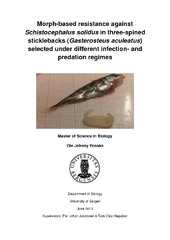Morph-based resistance against Schistocephalus solidus in three-spined sticklebacks (Gasterosteus aculeatus) selected under different infection- and predation regimes
| dc.contributor.author | Fossås, Ole Johnny | eng |
| dc.date.accessioned | 2013-09-05T12:02:58Z | |
| dc.date.available | 2013-09-05T12:02:58Z | |
| dc.date.issued | 2013-06-07 | eng |
| dc.date.submitted | 2013-06-07 | eng |
| dc.identifier.uri | http://hdl.handle.net/1956/7057 | |
| dc.description.abstract | The morphology of a host may have an effect on its resistance against parasites. Two geographically separated and morphologically divergent populations of three-spined sticklebacks (Gasterosteus aculeatus, Linnaeus, 1758) were experimentally infected with Schistocephalus solidus (Müller, 1776) through well documented methods. Extremely low prevalence of the parasite in both single-infection and mass-infection experiments, not previously documented, leave us with no satisfying conclusions on the effect of morphology on resistance, however compatibility and strong local adaptation are some points that are discussed and suggestions for future research are included. | en_US |
| dc.format.extent | 2272126 bytes | eng |
| dc.format.mimetype | application/pdf | eng |
| dc.language.iso | eng | eng |
| dc.publisher | The University of Bergen | en_US |
| dc.subject | Gasterosteus aculeatus | eng |
| dc.subject | stickleback | eng |
| dc.subject | Schistocephalus solidus | eng |
| dc.title | Morph-based resistance against Schistocephalus solidus in three-spined sticklebacks (Gasterosteus aculeatus) selected under different infection- and predation regimes | en_US |
| dc.type | Master thesis | |
| dc.rights.holder | Copyright the author. All rights reserved | en_US |
| dc.description.localcode | MAMN-BIO | |
| dc.description.localcode | BIO399 | |
| dc.subject.nus | 751999 | eng |
| fs.subjectcode | BIO399 |
